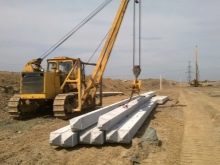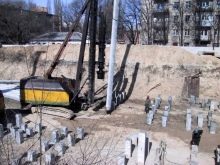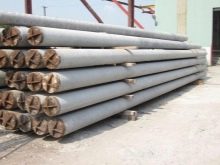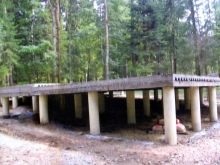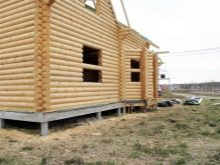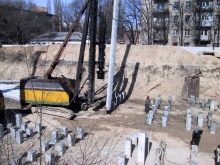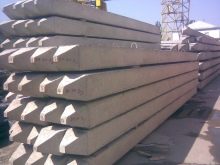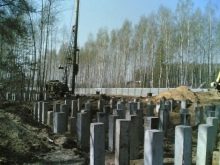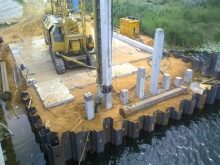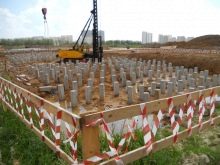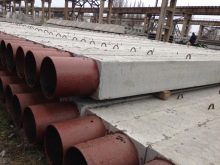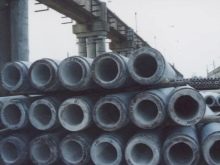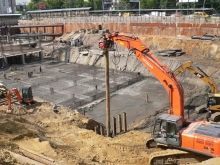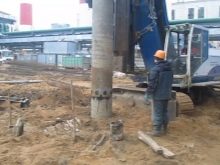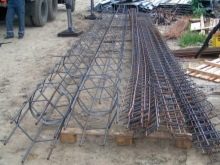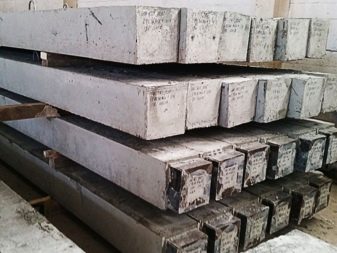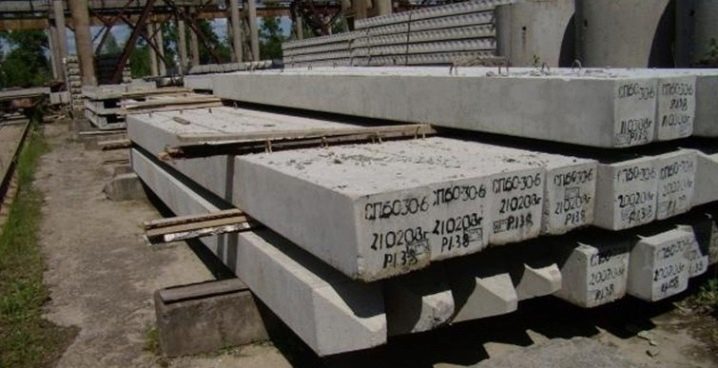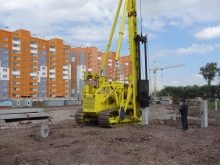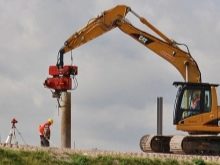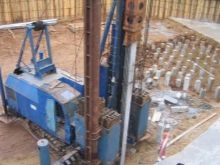Features of composite piles
Composite piles - reinforced concrete structures with a variety of sections, consisting of several elements that are interconnected. They create a support of up to thirty-six meters. Production conditions are specified in GOST 19804-2012. This set of standards was adopted in six countries of the Soviet Union, and came into effect in Russia in early 2014.
Application
Any of reinforced concrete piles is used to support the foundation and deepens to the level of high-density soil. If the sole is located in the ground is not very good, then the foundation will not be quite stable, which will cause soil subsidence under the mass of the building.
Composite piles are used in case of instability of the top layer of the construction site soil: if it is thicker than the length of the piles.As a rule, it is not allowed to support the pile base on such unstable soils, as peated soil, peatlands, flowing and highly compressible clay soil, and oozy soils. In the above soils, only the pile foundation will have stability and the necessary bearing capacity.
In addition, piles are used in the restoration of existing pile foundations, which strengthens this foundation. To do this, use the minimum dimensions of structures, consisting of five-meter sections.
Products from reinforced concrete equip foundations from piles on objects. The same structures are often used in construction companies that do not have a pile installation.
A standard dirt pile is 12 meters long. Composite reinforced concrete piles are also used when it is impossible to use conventional piles due to geological conditions. Such piles are used, for example, in construction work carried out on the territory of Moscow for the foundations of residential buildings, industrial buildings and various civilian buildings.
The purpose of the reinforced concrete pile is to transfer vertical loads.This will avoid shrinkage of the structure during construction and operation.
In the ground, you can use not one, but all species, provided that at the required depth of the soil there is a weak layer of rock and it is impossible to support.
Before starting work, composite piles must pass a static test, which will show the ability to withstand the types of load. Load test drive pass and joints connections. In the construction of foundations used such piles as trailing and piles-rack.
If construction of buildings with the subsequent increase in load of dynamics is supposed, it is better not to use composite piles for laying the foundation.
Design
Composite piles are manufactured according to GOST standards. They consist of upper and lower connecting parts.
Such piles have sections such as:
- 30x30 cm - the length of this section is in the range from 14 to 24 meters;
- 35x35 cm, 40x40 cm - from 14 to 28 meters.
The lengths of the connecting parts may vary. In the product, the cross section of which is 30x30 cm, the length of the lower base is from 7 meters, which increases with each step to 12 meters; for piles with a section of 35x35 cm and 40x40 cm, the length of such a foundation is from 8 to 14 meters.As for the upper section, at the pile of 30x30 cm it is within 5-12 meters, and at the pile of 35x35 and 40x40 - 6-14 meters.
Docking is done in the following ways:
- welding connection of the pledged glass;
- the connection of sheet steel plates that crimp the pile shaft;
- bolt connection of crimping element;
- connection with a folding lock;
- pin connection.
Composite piles must be reinforced with a longitudinal reinforcing cage made of a rod of class A2 and A3 with a diameter of 13-20 mm. The transverse reinforcement of the stem is made of metal mesh of wire of class B-1 with a minimum diameter of 5 mm.
For the production of body piles using heavy concrete class not lower than M200. The filling is small fraction gravel with a diameter of not more than 40 mm.
Reinforcement can occur by pre-tension technology. Before pouring concrete into the mold, the reinforcement cage is stretched with a hydraulic jack. This manufacturing technology gives piles maximum resistance to stress.
Distinctive features
A feature of this type of screw piles is the extension of the length of the trunk to the desired value using extension cords. The junction of the two parts is represented by a rigid connection with a welding attachment.
If we follow the production technology for building up, the process of lengthening a screw pile at a construction site will in no way affect the bearing capacity of the material, durability, strength and stability of the foundation.
This is determined by the strength of the soil and the bearing capacity of the material, which is determined by the strength of the material.
Specifications
In the table below you will see some calculation results:
Piles 30 * 30 cm, length 13-24 meters | Section 300 mm section, series 1.011.1-10, issue 1 | |||||||||
Title | Length (mm) | Width (mm) | Height (millimeter) | Weight (ton) | Volume (cubic meters) | Section | Weight (t) | Volume (cubic meters) | ||
S130-SV | 13,000 | 300 | 300 | 3 | 1,2 | S50.30-VSV. sixteen | 1,13 | 0,45 | ||
S140-SV | 14,000 | 3,2 | 1,3 | C60.30-VSV sixteen | 1,4 | 0,54 | ||||
S150-SV | 15000 | 3,4 | 1,4 | C70.30-VSV. sixteen | 1,6 | 0,6 | ||||
S160-SV | 16000 | 4 | 1,44 | S80.30-VSV 1/6 | 2 | 0,72 | ||||
S170-SV | 17000 | 3,8 | 1,5 | S80.30-NSV-3 | 0,73 | |||||
S180-SV | 18000 | 4,1 | 1,6 | S90.30-VSV 2.3 / 6 | 2,03 | 0,8 | ||||
C190-SV | 19000 | 4,3 | 1,7 | S100.30-VSV 2/6 | 2,3 | 0,9 | ||||
C200-SV | 20000 | 4,5 | 1,8 | S1.30.30-VSV 3/6 | 2,5 | 0,99 | ||||
S210-SV | 21000 | 4,7 | 1,9 | S120.30-VSV. 3/6 | 3 | 1,08 | ||||
S220-SV | 22000 | 5 | 2 | S80.30-NSV. sixteen | 2 | 0,73 | ||||
S230-SV | 23000 | 5,2 | 2,07 | S120.30-NSV. 3/6 | 2,7 | 1,09 | ||||
S240-SV | 24000 | 5,4 | 2,2 | |||||||
Piles 35 * 35 cm, length 13-28 meters | Section 350 mm section, series 1.011.1-10, issue 1 | |||||||||
Title | Length (mm) | Width (mm) | Height (millimeter) | Weight (ton) | Volume (cubic meters) | Section | Weight (t) | Volume (cubic meters) | ||
S130-SV | 13000 | 350 | 4,03 | 1,6 | C50.35-VSV. 2/6 | 1,6 | 0,6 | |||
S140-SV | 14000 | 4,34 | 1,7 | C60.35-VSV. 2/6 | 1,9 | 0,7 | ||||
S150-SV | 15000 | 4,64 | 1,9 | C60.35-BCB-4 | ||||||
S160-SV | 16000 | 4,96 | 2 | C70.35-VSV. 2/6 | 2,2 | 0,9 | ||||
S170-SV | 17000 | 5,3 | 2,11 | C80.35-VSV. 2.4 / 6 | 2,5 | 1 | ||||
S180-SV | 18000 | 5,6 | 2,23 | C90.35-VSV. 2/6 | 2,8 | 1,1 | ||||
C190-SV | 19000 | 5,9 | 2,4 | S100.35-VSV. 2/6 | 3,08 | 1,23 | ||||
C200-SV | 20000 | 6,2 | 2,5 | S110.35-VSV. 3/6 | 3,4 | 1,4 | ||||
S210-SV | 21000 | 6,5 | 2,6 | S120.35-VSV. 3/6 | 3,7 | 1,5 | ||||
S220-SV | 22000 | 6,82 | 2,7 | S130.35-VSV. 3/6 | 4 | 1,6 | ||||
S230-SV | 23000 | 7,13 | 2,9 | S140.35-VSV. 4/6 | 4,3 | 1,7 | ||||
S240-SV | 24000 | 7,44 | 3 | C80.35-NSV. 2.4 / 6 | 2,5 | 1 | ||||
S250-SV | 25000 | 7,75 | 3,1 | S120.35-NSV. 3/6 | 4 | 1,5 | ||||
S260-SV | 26000 | 8,06 | 3,2 | S120.35-NSV-4 | 3,7 | 1,47 | ||||
C270. -SV | 27000 | 8,4 | 3,4 | S140.35-VSV. 4/6 | 4,3 | 1,7 | ||||
S280-SV | 28000 | 8,7 | 3,5 | |||||||
Piles 40 * 40 cm, length 13-28 meters | Section 400 mm section, series 1.011.1-10, issue 1 | |||||||||
Title | Length (mm) | Width (mm) | Height (millimeter) | Weight (ton) | Volume (cubic meters) | Section | Weight (t) | Volume (cubic meters) | ||
S130-SV | 13000 | 400 | 5,2 | 2,08 | S50.40-VSV. 2/6 | 2 | 0,8 | |||
S140-SV | 14000 | 5,6 | 2,24 | C60.40-VSV 2/6 | 2,4 | 1 | ||||
S150-SV | 15000 | 6 | 2,4 | C70.40-VSV. 2/6 | 2,8 | 1,12 | ||||
S160-SV | 16000 | 6,4 | 2,6 | S80.40-VSV 2/6 | 3,2 | 1,3 | ||||
S170-SV | 17000 | 6,8 | 2,7 | S90.40-VSV 3/6 | 3,6 | 1,44 | ||||
S180-SV | 18000 | 7,2 | 2,9 | S100.40-VSV 3/6 | 4 | 1,6 | ||||
C190-SV | 19000 | 7,6 | 3,04 | S110.40-VSV. 4/6 | 4,4 | 1,8 | ||||
C200-SV | 20000 | 8 | 3,2 | S120.40-VSV. 4/6 | 4,8 | 2 | ||||
S210-SV | 21000 | 8,4 | 3,4 | S130.40-VSV. 4/6 | 5,2 | 2,08 | ||||
S220-SV | 22000 | 8,8 | 3,5 | S140.40-VSV. 5/6 | 6 | 2,24 | ||||
S230-SV | 23000 | 9 | 3,7 | S80.40-NSV. 2/6 | 3,3 | 1,3 | ||||
S240-SV | 24000 | 9,6 | 3,8 | S120.40-NSV. 4/6 | 4,9 | 1,94 | ||||
S250-SV | 25000 | 10 | 4 | C140.40-NSV. 5/6 | 5,7 | 2,3 | ||||
S260-SV | 26000 | 10,4 | 4,2 | |||||||
S270-SV | 27000 | 11 | 4,3 | |||||||
S280-SV | 28000 | 11,2 | 4,5 | |||||||
Types and marking
According to the provision of GOST, the following types of composite products are distinguished:
- piles with continuous quadratic section;
- hollow piles with round section;
- pile shells.
Composite piles have unified markings such as C260.35. CB, where:
- C - reinforced concrete pile with a solid square section;
- 260 - the length of all composite sections in decimeters;
- 35 - stem section in centimeters;
- SV - type of compound.
Immersion technique
Composite piles are immersed in the ground by hammering, which is carried out using a diesel or hydraulic hammer. In no case should vibro pile drivers be used when connecting, as the joined parts under such influence deform and become unsuitable for exploitation.
Driving technology occurs in the following order:
- slinging the lower part, then setting the trunk in a vertical position to the place of driving;
- the pile head should be placed under the head of the pile hammer, which is equipped with a support element that prevents deformation during driving;
- alignment of the vertical position, centering the axis and its relationship to the axis of the shock part of the diesel hammer;
- initial shocks should be carried out at a power of 20-25%, which is necessary for correct positioning in the first stage of the dive;
- after reaching a pile of 1.5–5 meters, driving at full power occurs until the head of the section is 30–50 cm above the ground;
- the second section joins the already driven into the ground (accuracy of movement is necessary here);
- The joint of the fixed glasses is fastened by electric arc welding, after which the composite pile is driven.
Upon completion, it is necessary to protect the weld with an anticorrosive Kuzbasslak - coal lacquer.
Foundations from driven piles require a huge consumption of metal. However, this minus is easily eliminated if more pre-stressed piles without transverse reinforcement are involved,if not with the final replacement.
For more solid and durable soils, piles having a collet connection are used. In the lower joint, a sleeve with a socket on the end is concreted, muffled by a plate.
The strength in place of the collet connection increases the strength of the entire pile, but it also has limitations:
- the ability of the collet joint should not exceed 60 tons;
- Piles of a collet connection can be used only in the “hanging” state - a restriction on the conditions of the soil.
Compound pile driving - in the next video.

